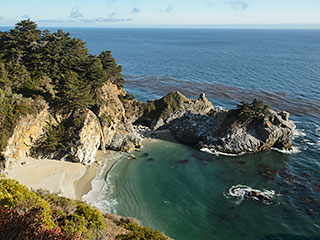 |
About Monterey Monterey History Attractions |
 Early Settlements
Early SettlementsMonterey's erliest inhabitants were Native Americans -- the Esalen and Ohlone. Europeans first saw Monterey when Portuguese explorer Juan Rodriquez Cabrillo spotted La Bahia de los Pinos in 1542 on a journey in search of riches in the New World. In 1602, Spanish explorer Don Sebastian Viscaino officially named the port in honor of Spain's Count of Monte Rey under whose order he was sailing. Viscaino's 200 men gave thanks for their safe journey in a ceremony held under a large oak tree overlooking the bay. In 1770, an expedition by land and sea brought Gaspar de Portol and Franciscan Father Junipero Serra to Monterey. There they established the Mission and Presidio of San Carlos de Borromeo de Monterey, and the City of Monterey. Under the same oak tree where Viscaino's crewmembers had prayed, Father Serra said mass for his brave group. A year later, in 1771, Father Serra moved the mission to nearby Carmel; the Presidio Church in Monterey, however, continued in use. Capital of Spanish California In 1776, Spain named Monterey the capital of Baja (lower) and Alta (upper) California. This same year, Captain Juan Bautista de Anza arrived with the first settlers for Spanish California, most of them bound for San Francisco. In April 1822, when Mexico gained its independence from Spain, Monterey became the Mexican capital. California soon pledged its loyalty to the Mexican government. Spain had not allowed foreigners to trade with California, but Mexico opened up the area to international trade, and Monterey was made California's sole port of entry. Traffic with English and American vessels for the hide and tallow trade became an important part of the economy. Statehood Attained In July 1846 Commodore John Drake Sloat's flagship arrived in Monterey Bay and his troops raised the American flag, claiming the region for the United States, and gaining the territory without a fight from the Mexicans. American occupation continued until the Treaty of Guadalupe Hidalgo was signed in 1848, making all of Alta California part of the United States. This included the land now known as California, Utah, Nevada, and parts of Arizona, Colorado, New Mexico, and Wyoming. In 1849, delegates from throughout Alta California met in Colton Hall in Monterey to create a constitution for the people of the new U.S. territory. The new constitution was signed on October 13, 1849. In 1850, the U.S. Congress voted to adopt California as the thirty-first state of the Union. San Jose was chosen as the seat for the first legislature. During the next decade Monterey lost much of its political influence. Sardine Trade Rise and Fall After California gained its statehood, the legislature formed counties. Monterey served as the Monterey County seat of government until 1873, when Salinas was named to that role. By the 1920s, the sardine market had grown greatly and the section of Monterey known as Cannery Row was established. During the next two decades, a score of canneries and reduction plants grew up in the area. Workers processed an estimated 250,000 tons of sardines each year. Monterey became known as the "Sardine Capital of the World." The rough and rollicking vicinity of Cannery Row was made famous in the John Steinbeck novels Cannery Row and Sweet Thursday. In the 1940s, for reasons still in dispute, the sardine population began a rapid decline. The once-thriving Cannery Row soon became a ghost town of empty warehouses. In the second half of the twentieth century, tourism once again gained importance and the old abandoned warehouses were converted into shops, restaurants, and galleries. Today, tourism has become the number one industry in Monterey, growing out of the city's efforts to preserve its historic and natural resources. Monterey has gained a reputation for excellence in environmental protection and this has served to enhance its visitor industry. |